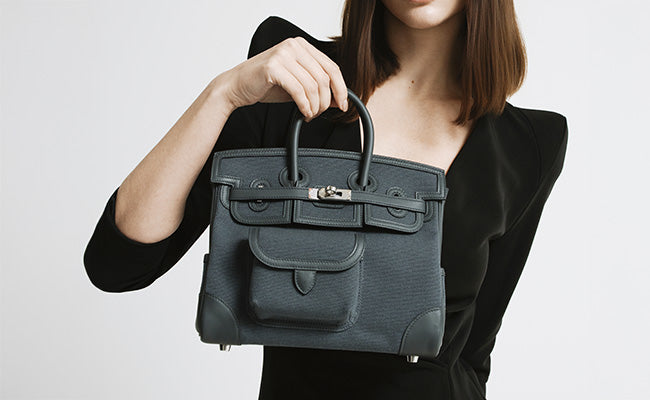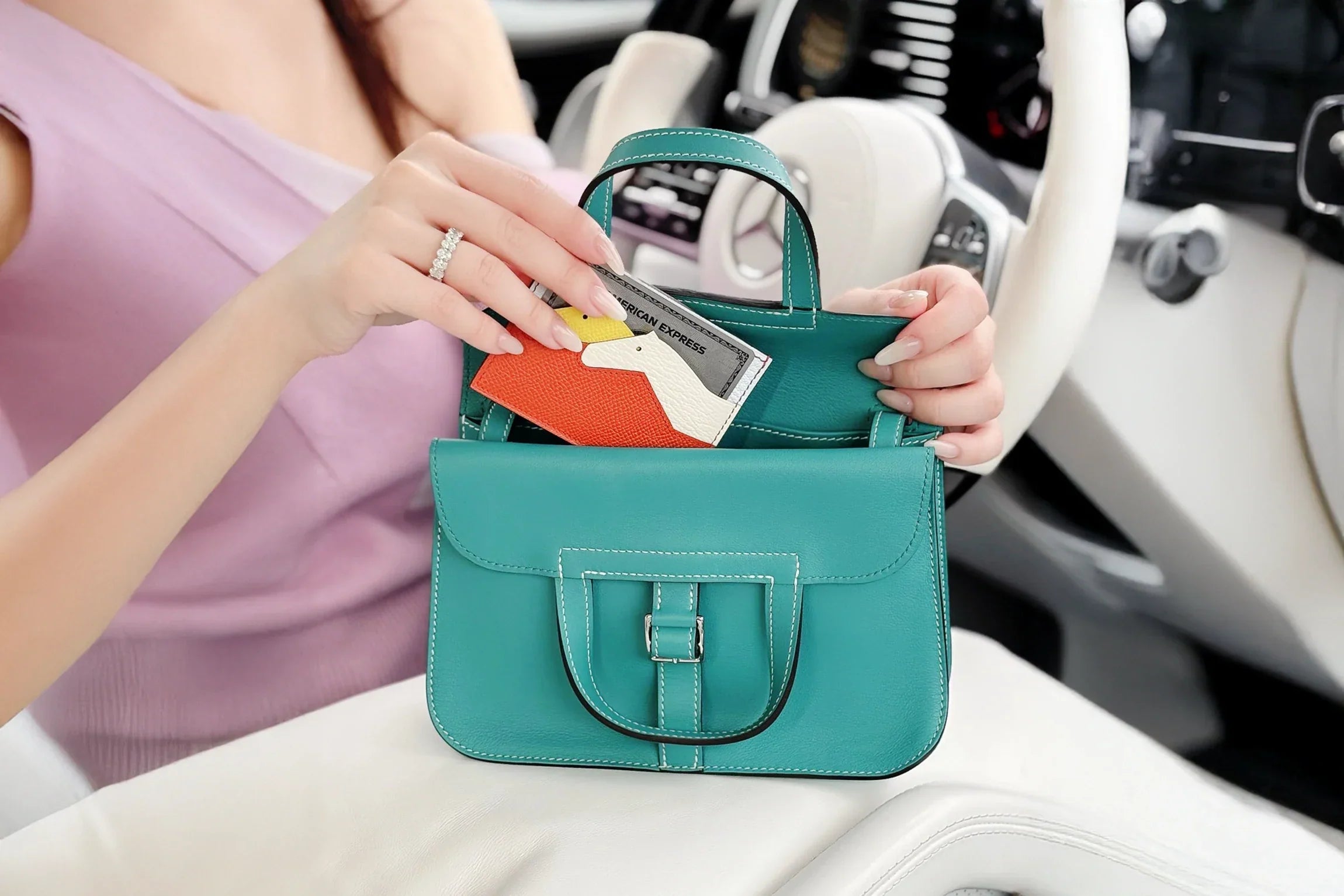
Essential Care Tips for Preserving Your Hermès Bag's Condition
Check out our Hermès collection and Birkin bags!
Caring for a Hermès bag isn’t just about preserving an accessory; it’s about honouring a true investment and a piece of art. To keep our cherished Hermès bags looking their best, we need to adopt smart daily habits, gentle cleaning routines, and be mindful of their surroundings. This blog post shares practical care tips that help maintain our bag’s beauty and value for years to come.
Each Hermès bag feels like its own character, with quirks, leathers, and hardware details that set it apart. From picking the right storage spot to handling it thoughtfully, small steps add up. Let’s figure out how to protect these treasures and actually enjoy carrying them, not just worry about every scuff.
Key Takeaways
- Proper care and storage maintain condition and value.
- Regular gentle cleaning protects materials and hardware.
- Smart daily habits help prevent damage and wear.
Understanding Your Hermès Bag
Every Hermès bag has its own features and construction details that shape its character, value, and care needs. When we understand materials, craftsmanship, and style identifiers, we set ourselves up to give our bags the attention they deserve.
Recognizing Signature Materials
Hermès uses legendary materials in the world of leather goods. We often see Togo, Clemence, and Epsom leathers, each with unique grains and finishes. For those who like a more exotic look, Hermès offers alligator, crocodile, ostrich, and lizard skins, each with special care requirements.
Togo’s pebbled grain stands out, while Epsom feels smooth and pressed. Exotic skins, with their scales or dots, are especially sensitive to moisture. Here’s a quick comparison:
| Material | Look/Feel | Durability | Care Tips |
|---|---|---|---|
| Togo | Pebbled, soft | High | Avoid heavy loads |
| Epsom | Smooth, stiff | Very high | Wipe gently |
| Crocodile/Alligator | Shiny, scaled | Sensitive | Moisture control |
Spotting these details helps us keep each bag’s personality intact.
Knowing the Value of Craftsmanship
Hermès bags are assembled by hand, one artisan per bag, with painstaking attention to each stitch. We appreciate the saddle stitching, which is both strong and aesthetically pleasing. The hardware is typically plated with precious metals, like palladium or gold, for longevity.
Small details set real Hermès bags apart. We can spot heat-stamped logos, well-set zippers, and hand-painted edges. Consistency in these areas hints at authenticity and the high standards behind every piece.
We might not see flaws, but these aren’t mass produced. Subtle irregularities in older bags can signal true craftsmanship. Many of us see character in these imperfections, knowing they are handmade.
Identifying Popular Styles and Models
Hermès is most famous for the Birkin and Kelly, but the brand’s lineup is far larger. The Birkin has dual top handles and a relaxed shape, while the Kelly is slightly more structured with its distinctive top handle and removable shoulder strap.
We often encounter the Constance, Picotin, and Evelyne, each with its own personality and purpose. Birkins and Kellys turn heads at events, while Picotins and Evelynes fit a day on the go.
Spotting a model involves looking at the bag’s shape, handles, clasps, and hardware. Recognizing these classic signatures helps us communicate about our bags with clarity and confidence.
Daily Handling Habits
Attention to daily details keeps our Hermès bags looking pristine year after year. Small, consistent actions can have a much bigger impact than one-off deep cleans or rushed repairs.
Properly Storing Between Uses
Proper storage is crucial for maintaining the shape and appearance of our Hermès bags. We should always empty the bag before putting it away, removing items that could press into the leather and leave marks.
Using a dust bag is non-negotiable. It shields the bag from dust, sunlight, and accidental spills. Storing our bags upright and stuffing them with acid-free tissue or a soft bag insert helps avoid sagging or creasing.
Never hang bags by their handles; this can stretch the leather and warp the overall shape. If space allows, dedicating a shelf or cubby for our Hermès collection prevents accidental bumps or friction with other items. Lastly, make sure the storage area is cool, dry, and away from direct sunlight.
Safeguarding Against Scratches
The leather on Hermès bags is durable, yet still susceptible to minor scratches. Keeping jewellery, watches, and belts with rough hardware away from the bag’s surface helps us avoid accidental scuffs.
When setting our bag down, we use a clean, soft surface like a chair or felt mat. Placing it on the floor is best avoided, especially outdoors or on textured pavement. Some of us stick felt protectors or acrylic feet on bag bottoms for extra defence.
A quick visual inspection after each use helps catch small marks early. With a gentle buff from a microfibre cloth, surface scuffs are often manageable before they set in. Prevention almost always works better than a fix.
Handling with Clean Hands
Clean hands are essential every time we handle our Hermès bags. Oils, lotions, or even traces of hand sanitizer can damage the leather, especially on lighter colours that reveal stains easily.
Washing hands with mild soap and drying thoroughly beforehand is a habit worth building. Avoid handling the bag immediately after applying cosmetics or fragrances.
For extra peace of mind, some of us use soft cotton gloves when moving bags for storage or during cleaning. This not only reduces the risk of dirty marks, but it also helps maintain that fresh-from-the-boutique finish we all love.
Cleaning and Maintenance Routine
Keeping our Hermès bag looking immaculate comes down to regular, gentle care and timely intervention. We avoid shortcuts and take maintenance seriously, trusting only proven techniques and respected professionals.
Dusting and Light Cleaning Techniques
Frequent dusting prevents dirt buildup and keeps the bag’s leather supple. We use a soft, dry microfibre cloth and delicately wipe down the surface, moving in small circular motions. For hard-to-reach corners, a lint-free cotton swab or a new, unused makeup brush works well.
After dusting, lightly dampening the cloth with distilled water can help lift smudges. We never saturate the leather. Finishing with a completely dry cloth ensures there’s no lingering moisture. We avoid using baby wipes or household cleaners, as they can discolour or damage the finish.
A quick routine once a week makes a big difference. For longer stretches of non-use, keeping the bag covered in its original dust bag helps prevent dust from settling.
Addressing Spills and Stains Quickly
Immediate action matters most when there's a spill or small accident. First, we gently blot (never rub) the affected area with a clean, soft cloth to absorb as much liquid as possible. If the spill is water-based, like coffee or juice, we use a slightly dampened cloth to dab the area then let it air dry naturally.
Oily stains are trickier. We sprinkle a tiny amount of cornstarch or talcum powder on the spot, wait a few hours, then softly brush it off with a very soft brush. We resist the urge to scrub, which can push the stain deeper.
For ink or dye transfer, we recommend not attempting removal ourselves, as aggressive cleaning may cause permanent blemishes. It’s best to store the bag away from newspapers or dark fabrics that may bleed colour onto the leather.
Safely Using Professional Cleaning Services
For deep cleaning or tough stains, we turn to vetted professional services with experience working on Hermès leather. It’s crucial to ask for references and details about their methods, as some cleaners might use strong chemicals that could harm the bag.
We bring our bag in its dust cover and always request an assessment before agreeing to any treatment. It’s wise to clarify if they perform cleaning by hand and whether they guarantee no solvent use on the leather.
When possible, we stick with the Hermès spa service for maintenance, as it uses their own gentle techniques and certified products. This option also helps protect the bag’s resale value and integrity, giving us peace of mind.
Climate and Environmental Protection
Proper storage and environmental mindfulness are non-negotiable when it comes to preserving a Hermès bag. We want our prized pieces to weather time stylishly, not just beautifully.
Shielding from Sunlight and Heat
Direct sunlight is no friend to Hermès leather. Prolonged exposure fades dyes, dries out the hide, and can even crack the delicate finish. Our best bet is to keep bags in low-light spaces, ideally in their original dust bags and boxes.
We should always avoid leaving bags near windows, radiators, or heating vents. Car interiors, especially in summer, act like ovens, so let’s skip storing bags there, even for short stints. For the ultra-precious exotic leathers, consistent shading is even more crucial; these materials are extra sensitive to UV rays and temperature shifts.
Here’s a quick reminder checklist for sun and heat protection:
| Do | Don’t |
|---|---|
| Store in a cool, shaded closet | Leave on sunny shelves |
| Use dust bags or soft covers | Place near heaters |
| Keep away from hot car interiors | Display under strong lamps |
Maintaining Optimal Humidity Levels
Humidity can make or break our Hermès bag's longevity. Too much moisture warps leather and can cause mould. Too little, and the leather dries out or peels, especially with exotic skins. We aim for a sweet spot: about 50-60 percent relative humidity is generally safe.
A small digital hygrometer in the closet is a smart investment. If we live somewhere damp, silica gel packets inside the storage box help absorb excess moisture. In dry climates, a simple humidifier will keep leather from stiffening or flaking.
Avoid storing our bags in plastic; leather needs to breathe. Soft, breathable cotton or felt covers are perfect. If we do spot condensation, wiping gently with a soft, dry cloth is key. Treating cheap plastics like “raincoats” for our Hermès is tempting, but it’s a shortcut we should skip.
Long-Term Storage Solutions
How we store our Hermès bags directly impacts the longevity and beauty of their leather, hardware, and structure. A few strategic storage decisions make the difference between a bag that ages gracefully and one that loses its lustre.
Choosing the Right Storage Location
Humidity, temperature, and light are the main factors we need to watch for when storing a Hermès bag. We should avoid basements, attics, or any area with extreme temperature fluctuations. Direct sunlight can fade and dry out leather, while damp spaces may invite mould.
The ideal space is a cool, dry closet with good air circulation. If the closet has glass doors, a simple opaque cover keeps out UV light. Never store bags in airtight plastic boxes, as leather needs to breathe.
A small, battery-operated dehumidifier or some silica gel packs help maintain proper humidity. We also keep the closet clean and dust-free to prevent accidental soiling.
Stuffing and Covering Properly
Maintaining the shape of our Hermès bags is essential for keeping them looking pristine. We always use soft, acid-free tissue, cotton batting, or bubble wrap (wrapped in cloth) to gently fill the bag’s body and help it hold its form. Overstuffing can stretch leather, so we avoid anything too bulky.
We never store our bags in their original Hermès boxes for extended periods, as this can flatten handles and corners. Instead, we use the original dust bag, or a soft, breathable cotton pillowcase, to shield the bag from dust and scratches.
For hardware, a gentle wrap with microfibre cloth prevents unwanted scuffs. We leave any zippers or clasps undone to avoid unwanted impressions on the leather.
Rotating Your Collection
Rotating our Hermès bags not only gives each one its moment in the spotlight but also prevents unnecessary wear in a single spot. Bags left in the same position for too long may develop creases or lose their natural silhouette.
We suggest creating a simple rotation schedule. Swap out which bag you carry and shift the bags’ storage spots every few months. Use a tracking app or a note in your phone if you have an extensive collection!
This practice allows us to regularly inspect each bag for signs of humidity, pests, or wear. It also keeps our collection organized and helps us appreciate every piece we own.
Managing Hardware and Fastenings
Metal details shape so much of our Hermès bags’ allure, but keeping them flawless isn’t always simple. It’s important we pay attention to their care, since even a small nick or dulling can stand out.
Preventing Tarnish and Scratches
If we want those palladium and gold hardware accents shining, regular gentle care is a must. Abrasive cleaners and rough cloths? Not a chance. We reach for a soft, lint-free microfibre cloth for a quick polish. If the hardware looks a bit dull, a barely dampened microfibre cloth followed by immediate drying usually does the trick.
Minimise direct hand contact, our skin’s natural oils build up and tarnish metal over time. We try to handle only the leather when possible, especially around lock plates and buckles. When putting the bag away, slipping any lock, keys, or cadenas into a dust bag or soft pouch helps prevent friction.
Small scratches can sometimes be gently buffed out with a clean cloth, but for anything deeper, Hermès after-sales service is the way to go. It’s a little effort, but it keeps those signature accents turning heads.
Caring for Zippers and Clasps
Zippers and clasps work hard, so we treat them right if we want them smooth and sturdy. Overstuffing? Bad idea, it puts pressure on fasteners and can twist or misalign them.
We open and close zippers slowly, using steady pressure and supporting them from behind when we can. If a zipper feels stiff, a swipe of clear candle wax or Hermès-approved lubricant along the teeth, then running it back and forth a few times, usually helps.
For turn-locks, snap closures, and buckles, alignment matters. We double-check they’re lined up before fastening, forcing or twisting is just asking for trouble. We keep an eye out for loose screws or misalignment so we can get repairs before things get worse.
Transport and Travel Tips
Caring for a Hermès bag doesn’t stop when we leave home. Travel brings new risks, rough handling, spills, you name it.
Packing Your Bag Safely
How we pack a Hermès bag makes a real difference. Always empty it and gently stuff with acid-free tissue or a soft scarf to keep its shape. Newspaper? Never, ink can bleed onto the lining.
We wrap hardware with felt or soft cloth (Hermès usually provides these) to prevent scratches. Then it goes in its dust bag, and that goes in a structured travel bag or box to avoid crushing. Carrying more than one bag? Don’t stack them, Hermès stays on top or somewhere safe with nothing pressing on it.
If possible, we never check the bag with luggage. Keeping it in the cabin helps avoid damage and theft. For extra protection, a rain cover inside the travel bag isn’t a bad idea if you expect humidity or messes.
Avoiding Travel Mishaps
Travel is unpredictable. We keep our Hermès bag away from food, drinks, and hand creams that could stain the leather. Hanging it on hooks or trolleys in airports? Nope, stretches the handles and exposes it to dirt.
If rain’s in the forecast, we pack a small umbrella and a waterproof dust bag. We set the bag on our lap or a clean surface, never the ground or public seats.
At airport security, if they want to inspect the bag, we ask for a tray lined with a cloth or use our own scarf. Letting it touch the scanner belt? No thanks. These little habits keep our Hermès looking flawless, even on the road.
Handling Wear and Patina
Caring for Hermès bags means balancing protection and letting them age with style. Good habits help keep them charming and prevent unnecessary damage.
Recognizing Natural Patina as Character
A Hermès bag’s patina isn’t just about age, it’s about the life it’s lived with us. Leather darkens or picks up a soft sheen over time. That’s not damage; it’s personality, and it makes each bag unique.
No need to obsess over every little mark or color shift. Leathers like Togo or Barenia are famous for their evolving patina. Embracing these changes gives our bag a personal flair no replica can match.
To keep patina even, we rotate bags, avoid too much sun, and use dust bags for storage. Think of patina as the bag’s “autograph” over the years.
Minimizing Corner and Handle Wear
Corners and handles take the most abuse, and yep, they show it first. We cut down on scuffing by setting our Hermès bag on clean, flat surfaces and picking it up with care, never yanking just one handle.
A few habits make a difference:
- Supporting handles with silk twillies keeps oils off the leather.
- Bag inserts and organizers help the bag keep its shape and keep corners from sagging.
- Regular, gentle cleaning stops dirt from building up on high-contact areas.
If wear creeps in, early attention from a pro can restore the look. Small steps now save a lot of stress (and cash) later.
Insuring and Authenticating Your Collection
When we invest in Hermès, we want to protect our pieces. Accurate documentation and the right insurance are key to keeping our luxury handbags secure.
Documenting Your Bag's Provenance
Keeping detailed records preserves value and makes authentication easier. We hang onto original receipts, store authenticity cards, and take high-res photos of each bag, serial numbers and craftsmanship details included.
A simple digital folder or spreadsheet works for cataloguing purchase dates, store locations, and any service or repair history. Including any correspondence with Hermès or reputable resellers is also smart. This boosts our confidence in authenticity and streamlines future sales or insurance claims.
By organizing our collections, we're guarding against loss, fraud, and confusion. No more guessing which shade our Birkin is or when our Kelly had its last spa.
Securing Luxury Insurance Coverage
Standard homeowner policies usually don’t cut it for luxury handbags. We look for specialized insurance providers who offer coverage tailored to high-value items like Hermès bags.
Key things to check:
- Agreed Value Coverage: Guarantees a set payout, not current market value.
- Worldwide Protection: Covers loss, theft, or damage anywhere we go.
- No Deductible Options: Some policies don’t make us pay out-of-pocket for claims.
Providing a recent appraisal or purchase invoice to the insurer helps. We update coverage as we add new pieces or if market values jump. Protecting our collection means less worry, more fun showing off those stunning bags.
Frequently Asked Questions
We all want our Hermès bags to stay gorgeous. Leather, hardware, storage tricks, and those little mishaps each need attention to keep our beauties in top shape.
What's the best way to keep my Hermès bag looking brand new?
We avoid overstuffing since it can stretch the leather and mess with the shape. Wiping the exterior with a clean, dry microfiber cloth after every outing keeps surface dirt at bay.
A seasonal visit to a professional Hermès spa or trusted bag specialist really helps. They know just how to pamper our leather.
Is there a secret trick for storing my Hermès bag when I'm not flaunting it?
We store ours upright in their original dust bags, away from direct sunlight and moisture. To keep the shape, we use a felt insert or acid-free tissue. Newsprint is a no-go, the ink can transfer.
We keep the original boxes, but let the bag breathe by leaving the lid slightly open.
Got any savvy tips for shielding Hermès leather from wear and tear?
We rotate our bags, no single bag gets all the use. On rainy days, we leave the most delicate leathers at home.
When setting bags down, we look for clean, dry surfaces and use the feet if possible to keep leather off the ground.
To spray or not to spray my Hermès, that is the question. Any advice?
We avoid commercial leather sprays or creams unless Hermès specifically recommends them. Most contain chemicals or oils that can change the color or texture.
When in doubt, we stick to Hermès-approved products or skip sprays altogether to protect the natural finish.
Can you recommend how to handle an accidental spill on my Hermès bag?
We gently blot, never rub, with a soft, dry cloth to soak up as much liquid as possible. Hairdryers, heaters, or scrubbing? Skip them. Let the leather air dry naturally.
After a spill, we contact Hermès customer service or a luxury leather specialist quickly. Fast, professional care gives us the best shot.
What do I need to know about caring for my bag's hardware to keep that sparkle?
We usually grab a clean microfiber cloth and gently wipe the hardware to take off fingerprints and oils. Steer clear of abrasive cleaners, they’ll just scratch things up or make the shine disappear.
If there’s tarnish or those little scratches, honestly, it’s better to let Hermès professionals handle it. DIY fixes at home? Probably not the best idea.




